
Journal of Clinical and Cellular Immunology
Open Access
ISSN: 2155-9899

ISSN: 2155-9899
Research - (2023)Volume 14, Issue 6
Vaccination is a critical intervention in the management of productive animals, but it is often associated with a transient reduction in milk production. The current study aimed to assess the extent of milk production loss in dairy animals following Foot and Mouth Disease (FMD), Hemorrhagic Septicemia and Black Quarter (HS and BQ), Theileriosis and Infectious Bovine Rhinotracheitis (IBR) vaccinations. The milk production data was collected 15 days before and after vaccination from 2018 to 2020 during different vaccination program. We found a significant (p<0.01; p<0.05) decrease in fortnightly total milk yield per animal and average milk yield per animal per day was observed in different parities and lactation stages following vaccination compared to pre-vaccination levels. Among the vaccinated animals, Sahiwal cows exhibited varying responses to vaccination, with 67.5 to 85.3% showing a decline in milk production, while 14.7 to 32.5% showed no significant effect on milk production after different vaccination program. In the case of affected Sahiwal cows, the extent of the decline in average daily milk yield per animal per day varied: 33–38% of animals showed a decline of up to 10%, 20–25% showed a 10–20% decline, 15–24% exhibited a 20–30% decline, 9–10% experienced a 30–40% decline and 9–15% showed a decline of more than 40% following vaccination. In conclusion, this study highlights the diverse responses of Bos indicus dairy animals to vaccination, with a range of percentages of milk production declines observed. So, there was a need for tailored vaccination strategies to mitigate the impact of vaccination on milk production while ensuring animal health and disease prevention. These findings have implications for the sustainable management of dairy cattle in regions where these diseases are prevalent.
FMD; IBR; HS and BQ; Milk production; Sahiwal cow; Theileriosis; Vaccination
Dairying in India plays a pivotal role in providing livelihoods to a significant proportion of the population, with landless and marginal farmers emerging as crucial stakeholders in this sector [1]. Notably, the dairy industry in India has undergone a substantial transformation, evolving into a technology-driven sector, as evident in the remarkable increase in milk production from 20.8 million tonnes in 1970 to 209.96 million tonnes in 2021, resulting in a per capita availability of approximately 427 grams of milk per day in 2020-21 [2]. However, amid this remarkable growth, the need for enhancing the production efficiency of individual animals becomes paramount.
Vaccination is a cornerstone of disease prevention in the livestock industry, offering protection against a variety of pathogens that can jeopardize animal health and welfare [3]. While the benefits of vaccination in preventing diseases are widely acknowledged, there was some evidence suggesting that the act of vaccination itself may have unintended consequences on the productivity of dairy animals, particularly in the context of milk production. In India, despite the potential benefits, the acceptance and penetration of vaccination remain uncertain [1]. To address this issue, National Animal Disease Control Program (NADCP) initiated in September 2019, to combat FMD and Brucellosis through widespread immunization efforts in cattle, buffalo, sheep, goats and pigs for FMD and female cattle calves aged 4 to 8 months for brucellosis (2019-20 to 2023-24). Nevertheless, a prevailing dogma among farmers in India regarding the potential adverse effects of vaccinating dairy animals, including decreased production performance, fertility issues, hyperthermia and stress, has contributed to a low adoption rate for vaccinations [3].
This study endeavors to explore and elucidate the intricate dynamics between vaccination and milk production in dairy animals. A better understanding of the effect of vaccination on milk production will facilitate informed decision-making and improved management strategies, ensuring the health and productivity of dairy animals while meeting the demands of a rapidly evolving dairy industry. The outcomes of this investigation are expected to provide valuable insights into the consequences of vaccination in the specific context of Indian dairy farming, shedding light on potential areas for improvement and development in the sector.
Location of the study
The study was conducted in the Livestock Research Centre (LRC) located at the Indian Council of Agricultural Research-National Dairy Research Institute (ICAR-NDRI), Karnal, Haryana, in a geographic orientation with an elevation (altitude) of 250 meters above the mean sea level, latitude 29°43” north and longitude 77°20” east. It has a subtropical climate, with annual minimum and maximum temperatures ranging from 4 to 45°C. Most rainfall occurs in July and August, with a yearly average of 70 cm. However, during the hot-humid season (July to September), the relative humidity varies from 41 to 85 percent and the vapor pressure from 7.0 to 25 mmHg. Thus, the experimental farm receives extreme hot and cold temperatures due to various metrological factors.
Management practices
Sahiwal cows were maintained under a loose housing management system. The paddock was large, open and brick-paved. A semiautomatic herringbone milking parlor system was used for milking. Feeding was done with seasonal green fodders like Berseem (Trifolium alexandrium), Maize (Zea mays) and Jowar (Sorghum) to all experimental animals. Dry fodder, such as wheat straw, was provided during the autumn when green fodder was scarce. The concentrate mixture of 70% Total Digestible Nutrients (TDN) and 20% Crude Protein (CP) was fed as per the milk yield. The concentrate was provided according to their maintenance and production performance. The concentrate was fed at the rate of 1 kg for every 2.5 kg milk yield, for an average of 4% fat.
Experimental design
In the present study, three years (2018-2020) of data on milk production from Sahiwal cows were collected. The day of vaccination was considered day 0 and the milk production data was collected from 15 days before to 15 days after vaccination. The stages of lactation and parity of the respective animals were also recorded. The total number of animals in milk at the time of vaccination during the study period was FMD (368), HS and BQ (204), Theileriosis (138) and IBR (62). Raksha-Ovac Trivalent (FMD Oil Adjuvant vaccine) contains tissue culture virus strains, O, A, Asia-1 and inactivated with Aziridine compound from Indian Immunologicals Ltd. was used for vaccination against FMD. Raksha-HS+BQ vaccine contains formalin-inactivated cultures of Pasteurella multocida and Clostridium chauvoei adjuvanted with aluminium hydroxide gel from Indian Immunologicals Ltd. used in vaccination for HS+BQ. Rakshavac-T from Indian Immunologicals Ltd. is used for prophylactic vaccination against Theileriosis. IBR marker vaccines from Boehringer Ingelheim Animal Health USA Inc. were used for vaccination against IBR.
Statistical analysis
Milk production data 15 days before and after vaccinations were collected and analyzed by paired sample t-test using Statistical Package for the Social Sciences (SPSS) 22.0 software (IBM Corporation, Armonk, New York, USA).
Effect of FMD vaccination on milk production of Sahiwal cows
The effect of FMD vaccination on fortnightly total milk yield/ animal and average milk yield per animal per day during vaccination in different parities and stages of lactation of Sahiwal cows have been documented (Figures 1-3). The present study shows a significant decline (p<0.01) in fortnightly total milk yield/ animal and average milk yield/animal/day in different parities and stages of lactation after vaccination. Fortnightly total milk yield per animal decreased to, i.e., 12.1, 12.1, 4.89, 8.34 and 10.13 kg in the first, second, third, fourth and fifth and above parities, respectively (Figure 1A). Sahiwal cows showed a decline of 8.32, 9.09 and 8.06 kg in fortnightly total milk yield per animal in the early, mid and late stage of lactation after vaccination, respectively (Figure 1B). The study depicted that after FMD vaccination, there was a significant decline (p<0.01) (p<0.05) in average milk yield per animal/day of 0.79, 0.80, 0.33, 0.56 and 0.65 kg/day in the first, second, third, fourth and fifth and above parities, respectively (Figure 2A). There was also a significant decrease (p<0.01) in average milk yield per animal/day in different stages of lactation, i.e., 0.55, 0.60 and 0.54 kg in the early, mid and late stages of lactation, respectively (Figure 2B). In FMD-vaccinated cows, the difference in average milk yield between pre-vaccination and postvaccination was plotted in a scatter plot (Figure 3) to understand the effect of vaccination on individual Sahiwal cows. The milk yield data below the “0” line showed a decline in milk yield and the data above the “0” line showed no effect on the milk production of the Sahiwal cows after FMD vaccination. Interestingly, it has been observed that out of 368 Sahiwal cows in milk during vaccination, 248 (67.39%) Sahiwal cows showed a decline in milk yield after vaccination and 120 (32.61%) Sahiwal cows showed no effect of vaccination on milk production. Out of the affected Sahiwal cows, 38.58% of animals showed a decline in average daily milk yield up to 10%, 25% of animals 10-20%, 15.21% of animals showed a 20- 30%, 9.23% of animals showed a 30-40% and 11.95% of animals showed more than 40% decline.
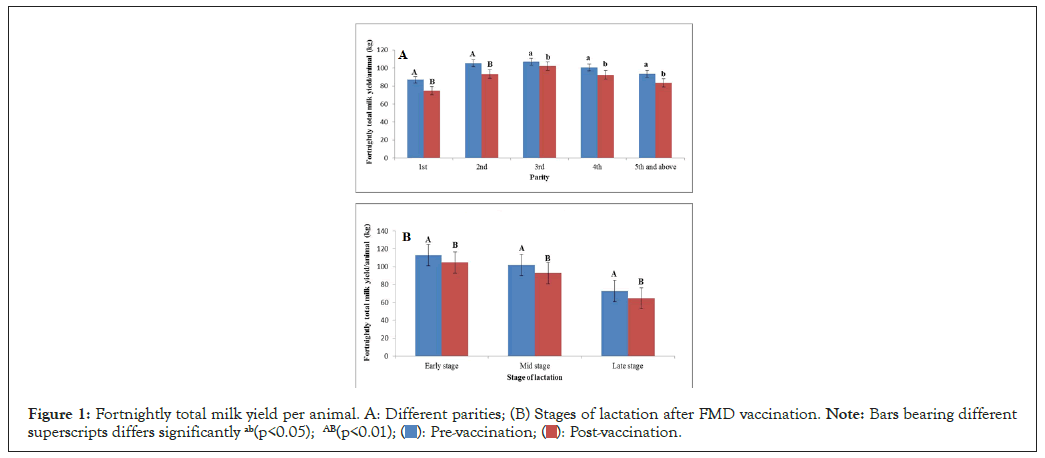
Figure 1: Fortnightly total milk yield per animal. A: Different parities; (B) Stages of lactation after FMD vaccination. Note: Bars bearing different
superscripts differs significantly ab(p<0.05); AB(p<0.01); 
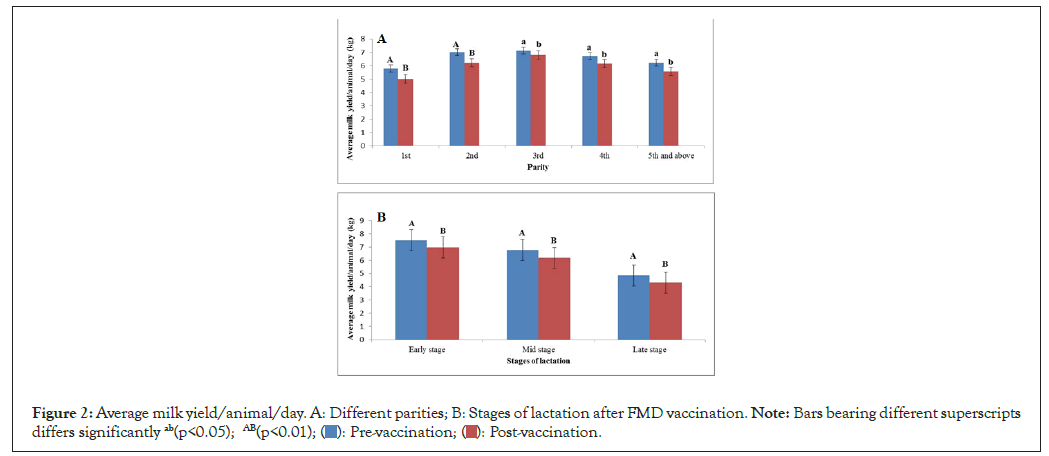
Figure 2: Average milk yield/animal/day. A: Different parities; B: Stages of lactation after FMD vaccination. Note: Bars bearing different
superscripts differs significantly ab(p<0.05); AB(p<0.01); 
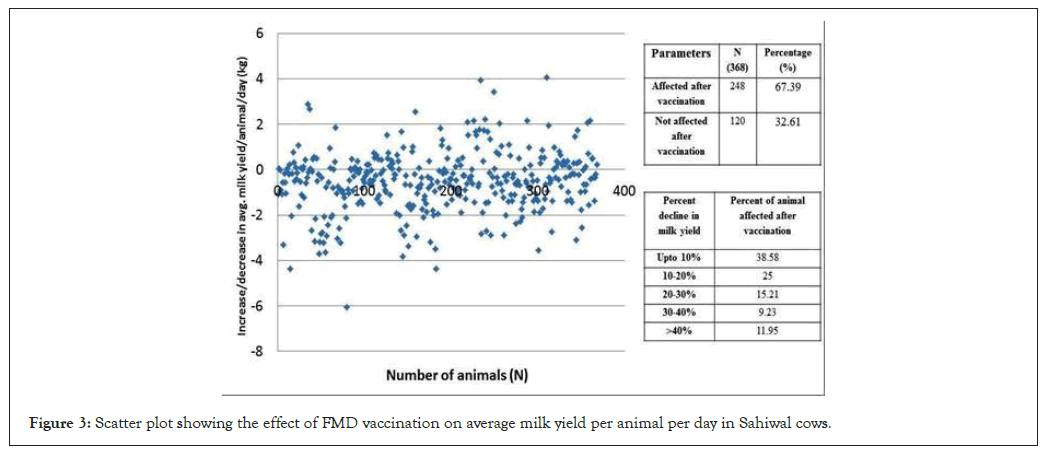
Figure 3: Scatter plot showing the effect of FMD vaccination on average milk yield per animal per day in Sahiwal cows.
Effect of HS+BQ vaccination on milk production of Sahiwal cows
The results of the effect of HS+BQ vaccination on fortnightly total milk yield per animal and average milk yield per animal per day during vaccination in different parities and stages of lactation of Sahiwal cows have been documented (Figures 4-6). The present study shows a significant decline (p<0.01) (p<0.05) in fortnightly total milk yield/animal and average milk yield/animal/ day in different parities and stages of lactation after vaccination. Fortnightly total milk yield per animal decreased to, i.e., 7.2, 12.47, 15.76, 13.21 and 10.85 kg in the first, second, third, fourth and fifth and above parity, respectively (Figure 4A). Sahiwal cows showed a decline of 9.93, 11.09 and 20.83 kg in fortnightly total milk yield per animal in the early, mid and late stage of lactation after HS+BQ vaccination, respectively (Figure 4B). The study depicted that after HS+BQ vaccination, there was a significant decline in average milk yield per animal/day of 0.92, 0.79, 1.07, 0.88 and 0.72 kg in the first, second, third, fourth and fifth and above parities, respectively (Figure 5A). There was also a significant decrease (p<0.01) in average milk yield per animal/day in different stages of lactation, i.e., 0.66, 0.73 and 1.36 kg in the early, mid and late stage of lactation, respectively (Figure 5B). In the case of HS+BQ vaccination, the difference in average milk yield per animal per day of pre-vaccination and post-vaccination data was plotted in a scatter plot (Figure 6) to understand the effect of vaccination on individual Sahiwal cows. The milk yield data below the “0” line showed a decline in milk yield and above the “0” line showed no effect on the milk production of the Sahiwal cows after HS+BQ vaccination. Interestingly, out of 204 Sahiwal cows in milk during vaccination, 151 (74.2%) showed a decline in milk yield after vaccination and 53 (24.98%) showed no effect of vaccination on milk production. Out of affected Sahiwal cows, 37.75% of animals showed a decline in average daily milk yield per up to 10%, 20.10% of animals showed a 10-20%, 15.20% of animals showed a 20-30%, 9.80% of animals showed a 30-40% and 17.15% of animals showed more than 40%.
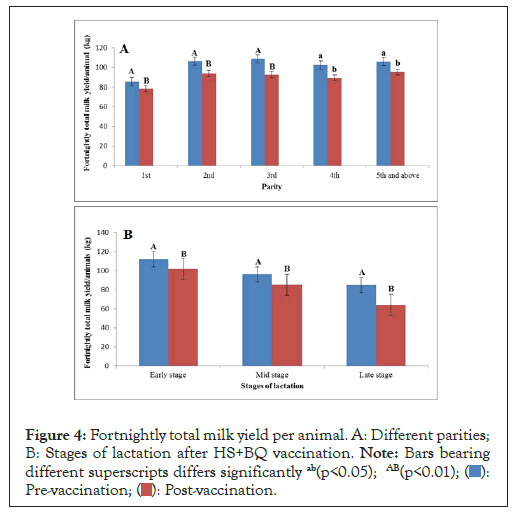
Figure 4: Fortnightly total milk yield per animal. A: Different parities;
B: Stages of lactation after HS+BQ vaccination. Note: Bars bearing different
superscripts differs significantly ab(p<0.05); AB(p<0.01); 
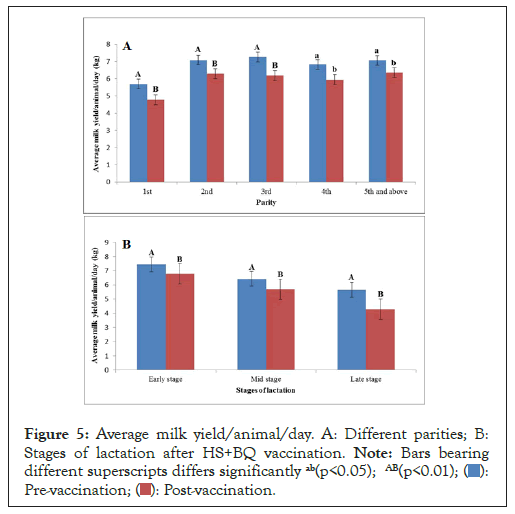
Figure 5: Average milk yield/animal/day. A: Different parities; B:
Stages of lactation after HS+BQ vaccination. Note: Bars bearing different
superscripts differs significantly ab(p<0.05); AB(p<0.01); 
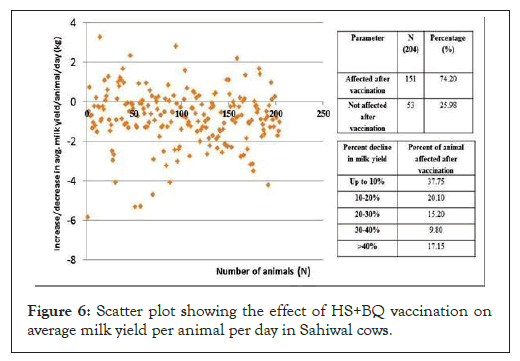
Figure 6: Scatter plot showing the effect of HS+BQ vaccination on average milk yield per animal per day in Sahiwal cows.
Effect of theileriosis vaccination on milk production of Sahiwal cows
The results of the effect of theileriosis vaccination on fortnightly total milk yield per animal and average milk yield per animal/day during vaccination in different parities and stages of lactation of Sahiwal cows have been documented (Figures 7-9). The present study shows a significant decline (p<0.05) in fortnightly total milk yield per animal and average milk yield per animal/day in different parities and stages of lactation after vaccination. Fortnightly total milk yield per animal decreased to, i.e., 5.43, 9.56, 7.62, 7.13 and 8.61 kg in the first, second, third, fourth and fifth and above parities, respectively (Figure 7A). Sahiwal cows showed a decline of 7.40, 8.09 and 10.09 kg in fortnightly total milk yield per animal in the early, mid and late stage of lactation after vaccination, respectively (Figure 7B). The study depicted that after theileriosis vaccination, there was a significant decline (p<0.05) in average milk yield per animal/day of 0.37, 0.65, 0.76, 0.48 and 0.57 kg in the first, second, third, fourth and fifth and above parities, respectively (Figure 8A). There was also a significant decrease (p<0.05) in average milk yield per animal/day in different stages of lactation, i.e., 0.55, 0.60 and 0.54 kg in the early, mid and late stage of lactation, respectively (Figure 8B). In the case of theileriosis vaccination, the difference in average milk yield per animal per day between pre-vaccination and post-vaccination was plotted in a scatter plot (Figure 9) to understand the effect of vaccination on individual Sahiwal cows. The milk yield data below the “0” line showed a decline in daily milk yield and above the “0” line showed no effect on the daily milk production of the Sahiwal cows after the theileriosis vaccination. Interestingly, it has been observed that out of 136 Sahiwal cows milking during vaccination, 93 (68.62%) showed a decline in milk yield after vaccination and 43 (31.38%) did not show any effect of vaccination on milk production. Out of affected Sahiwal cows, 33.08% of animals showed a decline in average daily milk yield per animal up to 10%, 22.79% of animals showed a 10–20% decline, 16.92% of animals showed a 20–30% decline, 9.56% of animals showed a 30–40% decline and 17.65% of animals showed a more than 40% decline.
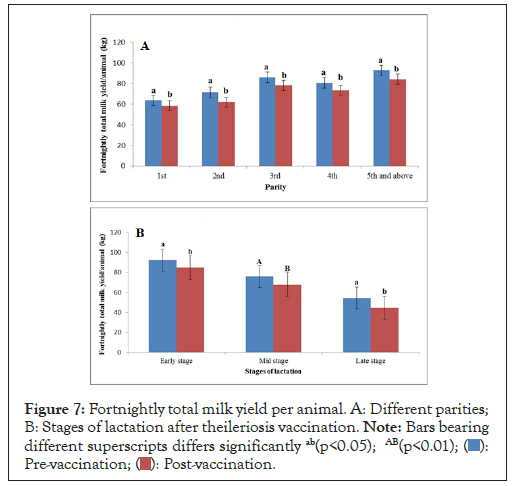
Figure 7: Fortnightly total milk yield per animal. A: Different parities;
B: Stages of lactation after theileriosis vaccination. Note: Bars bearing different
superscripts differs significantly ab(p<0.05); AB(p<0.01); 
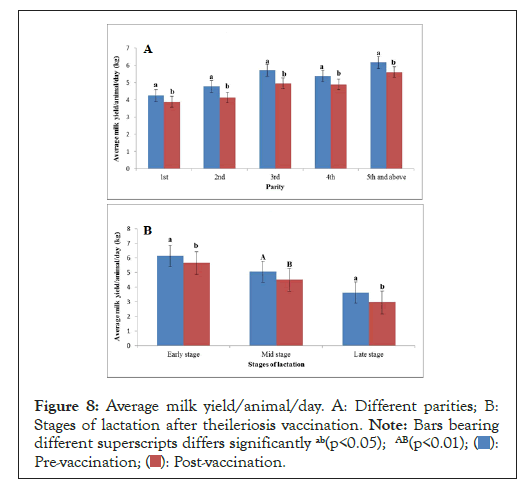
Figure 8: Average milk yield/animal/day. A: Different parities; B:
Stages of lactation after theileriosis vaccination. Note: Bars bearing different
superscripts differs significantly ab(p<0.05); AB(p<0.01); 
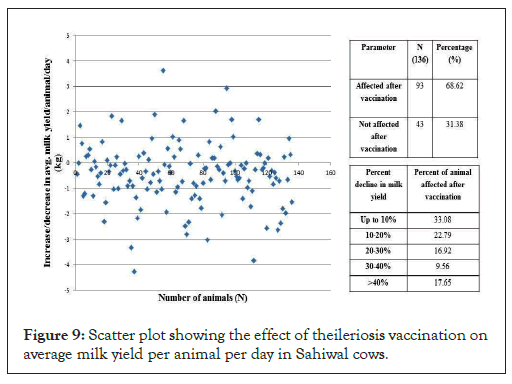
Figure 9: Scatter plot showing the effect of theileriosis vaccination on average milk yield per animal per day in Sahiwal cows.
Effect of Infectious Bovine Rhinotracheitis (IBR) vaccination on milk production of Sahiwal cows
The results of the effect of IBR vaccination on fortnightly total milk yield per animal and average daily milk yield per animal per day after vaccination in different parities and stages of lactation of Sahiwal cows have been documented (Figures 10-12). The present study shows a significant decline (p<0.01) (p<0.05) in fortnightly total milk yield in the third, fourth and fifth and above parities and in different stages of lactation. There was also a significant decline in average milk yield per animal/day in the third, fourth and fifth and above (p<0.05) parities and early, mid (p<0.01) and late (p<0.05) stages of lactation after vaccination. Fortnightly total milk yield per animal decreased to, i.e., 9.25, 5.96, 12.38, 21.69 and 13.60 kg in the first, second, third, fourth and fifth and above parities, respectively (Figure 10A). Sahiwal cows showed a decline of 10.45, 15.22 and 16.50 kg in fortnightly total milk yield per animal in the early, mid and late stage of lactation vaccination, respectively (Figure 10B). The study depicted that after IBR vaccination, there was a significant (p<0.05) decline in 0.80, 1.25, 0.91 kg in average milk yield per animal/day in the third, fourth and fifth and above parity and non-significant decline of 0.61 and 0.40 kg per animal/ day in the first and second parity, respectively (Figure 11A). A significant decrease in average daily milk yield per animal/day in different stages of lactation, i.e., 0.70, 1.02 and 1.03 kg in early and mid-stage (p<0.01) and late stages of lactation (p<0.05) after IBR vaccination, respectively was recorded (Figure 11B). In the case of IBR vaccination, the difference in average milk yield per animal per day between pre-vaccination and post-vaccination was plotted in a scatter plot to understand the effect of vaccination on individual Sahiwal cows (Figure 12). The milk yield data below the “0” line showed a decline in milk yield, while the data above the “0” line showed no effect on the milk production of the Sahiwal cows after IBR vaccination. Interestingly, it has been observed that out of 61 Sahiwal cows in milk during vaccination, 52 (85.24%) showed a decline in milk yield after vaccination and 9 (14.76%) showed no effect of vaccination on milk production. Out of affected Sahiwal cows, 37.71% of animals showed a decline in average daily milk yield up to 10%, 19.67% of animals showed a 10-20% decline, 24.59% of animals showed a 20-30% decline, 9.84% animals showed a 30–40% decline and 8.19% animals showed more than 40% decline.

Figure 10: Fortnightly total milk yield per animal. A: Different parities;
B: Stages of lactation after IBR vaccination. Note: Bars bearing different
superscripts differs significantly ab(p<0.05); AB(p<0.01); 
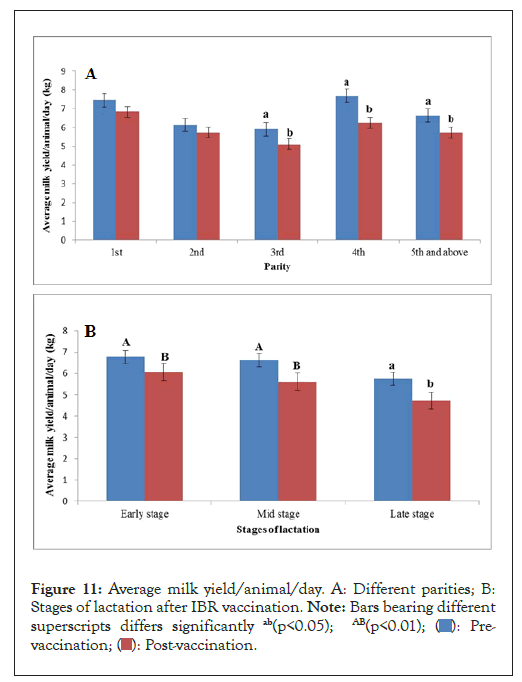
Figure 11: Average milk yield/animal/day. A: Different parities; B:
Stages of lactation after IBR vaccination. Note: Bars bearing different
superscripts differs significantly ab(p<0.05); AB(p<0.01); 

Figure 12: Scatter plot showing the effect of IBR vaccination on average milk yield/animal/day in Sahiwal cow.
The most effective way to prevent disease and protection of livestock is vaccination. Most animals experience stress during vaccination, which affects the development of their immunity to the vaccination [4]. Vaccination causes stress, classified as acute stress that helps prime the immune system and chronic stress that harms the humoral immune response [5]. The transient loss of milk production and vaccination-associated animal stress are topics that have been well brainstormed among researchers [6-8]. Although some research found no negative vaccination effects on milk production, other studies have found transient fever and post-vaccinal milk decline in dairy cattle [9]. Species and breed-wise reduction in milk associated with vaccination has been studied, especially in cattle; Holstein Friesian cattle, Deoni and Crossbred cattle, sheep and goat [6- 8,10-13]. The possible reason for the post-vaccination milk drop is due to a transient fever that reduces milk production in some cows. The effects of vaccination on milk yield appear transient and cannot be seen on 305-day yields [14]. Based on the timing of the post-vaccination milk decrease described in the literature, we chose a trial period in this investigation that lasted from 15 days before vaccination to 15 days after vaccination to find the total loss of milk for a temporary period after vaccination. According to Bosch, et al measuring the mean milk production over a long period would make it impossible to detect even significant shortterm impacts if a longer period after immunization is chosen [15]. They also found substantial (p<0.05) decline in daily milk output of around 1.4 kg per cow. According to the present study, Musser, et al observed a loss of milk production between 0.6 and 1.8 kg per day per animal for three days following Escherichia coli bacterintoxoid vaccine administration in dairy cows and they also reported that vaccinated cows also produced milk at a rate that was around 7% lower than that of controls [9]. Krishnaswamy, et al investigated the short-term impact of FMD vaccination on corrected milk yield, the Deoni cow saw a slight decrease of 90 g per day; however, in the crossbred cow, there was a 360 g decline from pre-vaccination milk yield [13]. Scoot, et al noted a significant (p<0.05) decline in milk production (-2.53 kg/d) one day following vaccine containing four killed viruses Bovine Herpes Virus-1 (BHV-1), Bovine Respiratory Syncytial Virus (BRSV), Bovine Viral Diarrhea Virus (BVDV) and Para-Influenza-3 Virus (PI-3V) in combination with a 5-way Leptospiral bacterin in dairy animals [12]. Like the present study, Schulze, et al observed a decrease in daily milk production in vaccinated cows compared to non-vaccinated cows (26.8 ± 0.39 vs. 28.2 ± 0.44 kg) after phase I inactivated Coxiella burnetii vaccine [10]. Abutarbush, et al investigated the impact of the Lumpy Skin Disease (LSD) vaccine on milk production and observed a 5.5-16% decrease in daily milk production [11]. According to the present study, Bergeron, et al observed milk production losses of -1.83 and -0.63 kg per day in Vaccine C (cattle master gold FP 5) and Vaccine T (triangle 4+type 2 BVD) group compared to the control (saline, -0.02 kg per day) [7]. Morgemstem, et al reported a 0.41 kg decrease in daily milk yield for five days after LSD vaccination [8]. After receiving Mannheimia haemolytica sub-unit immunization, Armfelt, et al reported a 0.7 kg daily milk yield reduction for three days [16]. A herd-specific Staphylococcus aureus vaccine or a commercial polyvalent vaccine against mastitis results in significantly lower milk production and 305-day milk yield in the vaccinated group compared to the control group [17]. According to Angelova, et al cows vaccinated against LSD had daily milk production that was 27.79 kg before vaccination and 24.31 kg after vaccination (p<0.001) [18]. The post-vaccinal effects of FMD vaccination in a herd of Jersey and Red Dane cows caused a slight reduction in milk yield observed in the vaccinated cows, which continued from 4 to 5 days. The total loss in milk yield ranged from 4.25 to 8.5 percent, with an average daily loss of about 6.0 percent of the total yield [19]. According to Pramod, et al the average milk production (mean ± SE) before and after FMD vaccination was 7.68 ± 0.28 and 7.07 ± 0.28 kg, respectively [20]. The highest losses were observed on the first day after vaccination, with a mean of 0.58 ± 0.09 kg and the total milk yield of the herd rebounded to pre-vaccination levels by the sixth day after vaccination. The average cumulative production loss calculated over the period was 1.93 kg per animal. Various authors reported a decrease in milk yield after vaccination, which corroborated our study. The differences in findings between different authors in the quantum of decrease in milk production after vaccination varied across the studies due to variations in the type of vaccine, breed, parity, stages of lactation, management and environmental factors. The duration and magnitude of milk yield reduction depend on the type of vaccine (live or killed), including antigens, the type of adjuvant, production and stage of lactation of the animal, as well as from environmental factors [21-34].
It has been concluded that vaccination may cause a significant decline in fortnightly total milk yield/animal and average milk yield/animal/day in different parities and stages of lactation after FMD, HS and BQ, Theileriosis and IBR vaccination. Among the vaccinated animals 67.5 to 85.3 percentage showed a decline in milk production, whereas 14.7 to 32.5 % showed no effect in milk production after vaccination. So, ameliorative strategies can be formulated to minimize the vaccination stress in dairy animals using ideal adjuvants, DNA vaccines and immunomodulators. Moreover, we must create proper awareness of transient vaccination stress on milk production loss and individual variability of dairy animals.
Indian Council of Agricultural Research.
Acknowledged the Director of ICAR-NDRI, Karnal, for providing the research and academic facilities required for the study.
[Crossref] [Google Scholar] [PubMed]
[Crossref] [Google Scholar] [PubMed]
[Crossref] [Google Scholar] [PubMed]
[Google Scholar] [PubMed]
[Google Scholar] [PubMed]
[Crossref] [Google Scholar] [PubMed]
[Google Scholar] [PubMed]
[Crossref] [Google Scholar] [PubMed]
[Crossref] [Google Scholar] [PubMed]
[Google Scholar] [PubMed]
[Crossref] [Google Scholar] [PubMed]
[Crossref] [Google Scholar] [PubMed]
[Crossref] [Google Scholar] [PubMed]
[Crossref] [Google Scholar] [PubMed]
[Google Scholar] [PubMed]
[Crossref] [Google Scholar] [PubMed]
[Crossref] [Google Scholar] [PubMed]
[Crossref] [Google Scholar] [PubMed]
[Crossref] [Google Scholar] [PubMed]
[Google Scholar] [PubMed]
[Google Scholar] [PubMed]
[Crossref] [Google Scholar] [PubMed]
[Crossref] [Google Scholar] [PubMed]
[Crossref] [Google Scholar] [PubMed]
[Crossref] [Google Scholar] [PubMed]
Citation: Rajput AS, Bhakat M, Mohanty TK, Maity S, Mondal G, Mir AA, et al (2023) Impact of Vaccination on Milk Production in Sahiwal Cows under Tropical Conditions (Bos indicus): A Longitudinal Study. J Clin Cell Immunol. 14:702.
Received: 28-Oct-2023, Manuscript No. JCCI-23-27867; Editor assigned: 30-Oct-2023, Pre QC No. JCCI-23-27867 (PQ); Reviewed: 13-Nov-2023, QC No. JCCI-23-27867; Revised: 20-Nov-2023, Manuscript No. JCCI-23-27867 (R); Published: 27-Nov-2023 , DOI: 10.35248/2155-9899.23.14.702
Copyright: © 2023 Rajput AS, et al. This is an open-access article distributed under the terms of the Creative Commons Attribution License, which permits unrestricted use, distribution and reproduction in any medium, provided the original author and source are credited.